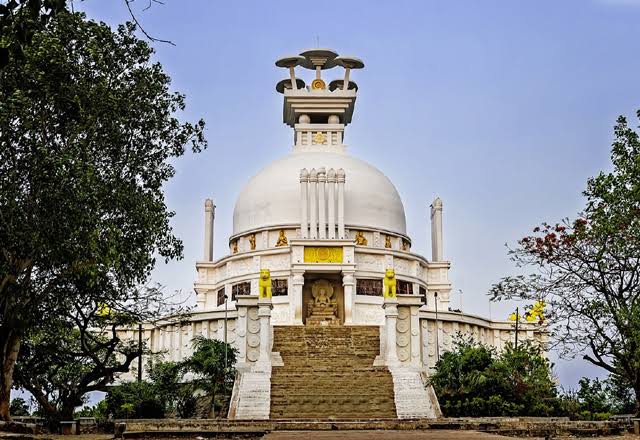Bhubaneswar: Dhauli Shanti Stupa known Internationally as Peace Pagoda is located 8 km south on the outskirts of Bhubaneswar. It is constructed at the top of Dhauli Hills which is close to the riverbank of Daya River. It was a collaboration between Kalinga Nippon Sangha and the Odisha Government. It was completed in 2 years and inaugurated on 8th November 1972. It was constructed to mark the famous Kalinga War which was fought along the river banks of Daya River. The war changed Chanda Ashoka (fierce warrior) to Dharma Ashoka (peace lover) which was great enlightenment. Emperor Ashok turned himself Buddhist and he started spreading Buddhism.
It has four massive idols of Lord Buddha in different postures along with Gautam Buddha’s life. These are all carved on stone slabs. It has various rock edicts, which are a living testimony of emperor Ashoka’s transformation. Historians say Ashoka wrote ‘welfare of the whole world’ which depicts his concern about humanity. A rock-cut elephant above the edicts is one of the oldest Buddhist sculptures in Odisha.
The beautiful dazzling white DhauliGiri Shanti Stupa is a dome-shaped structure that is embellished with fascinating stone panels which are eye-catching and can hold one’s attention. There are some amazing stone carvings of Lord Buddha in different postures along with a relaxing posture. His footprints, Dharma chakra were used as decoration in Buddhist temples, statues, and inscriptions from the earliest period of Indian Buddhism. The Bodhi tree is a large and sacred fig tree. Some stone panels are inscribed with the scenes when Emperor Ashoka was offering his sword to Lord Buddha and resigning from the war, an elephant and horseback procession, and various Buddhist anthems.
HISTORY BEHIND THE SHANTI STUPA
In the year 262 B.C. the Kalinga War was fought between the Mauryan Empire and the Kalinga kingdom(states of Kalinga). All the trade routes of Southeast Asia were controlled by Kalinga. Due to this, Ashoka, the Mauryan king, wanted to rule over Kalinga. Therefore he leads his huge army to Kalinga. Although he won the war, he realized the futility of the war. The great Maurya dynasty’s legendary king Ashoka looked down from over the vast expanse of the battlefield of Kalinga; now the area near Dhauli scattered with bodies, after a fierce battle. He saw the bloodshed and suffering of the soldiers’ families and at that moment he solemnly promised never to fight again. Even after a victory, the sight of the aftermath destruction of the war and death horrified him and resulted in his transformation.
He converted himself to Buddhism and dedicated his entire life in helping his followers. He left the conquest. He wrote inscriptions for his son and grandson to never think about war. He decided to observe Dhamma. Dhamma means ‘to uphold’, it is based upon the actions and teachings of the buddha.
He transferred his energy, which he used to spend in winning wars and fighting, to spiritual activity. He became a Buddhist and a follower of Buddha’s teachings and started living a sober, solemn, simple and life without any luxury.
He also thought about the practicality of wars which only brings destruction and death and misery to humanity. Due to this thought, the Great Warrior became a follower of Buddhism and spent his whole life spreading the teachings of Buddha first in Odisha then all around the world.
Carvings of an elephant emerging from the rock are the mark where the transformation of the heart and thoughts of Ashoka took place. It is the oldest rock-cut sculpture in India around the 3rd century B.C. This symbolizes the birth of Buddha and the emergence of Buddhism.
UNIQUENESS OF DHAULI STUPA
The narrative history is carved by king Ashoka on the cliff rock, onto the pillars and caves throughout India. It suggests that the ruling area may have had two administrative headquarters. There were instructions carved on the stones addressing his administrators which was about how to rule his subjects. Which are something like this —“ Your motive should be to gain the affection of humanity. All humans are our children, and as I always want my children to obtain welfare and happiness both in this world and the other world side of the world, the same I should desire for all …”
These edicts showed the remarkable transformation of a Great merciless and heatless warrior king to a kind and warm-hearted soul who dedicated his life to the Buddhist way of living that was enlightened and harsh to live for a Great warrior. These inscriptions were clearly visible even after 2000 years.







